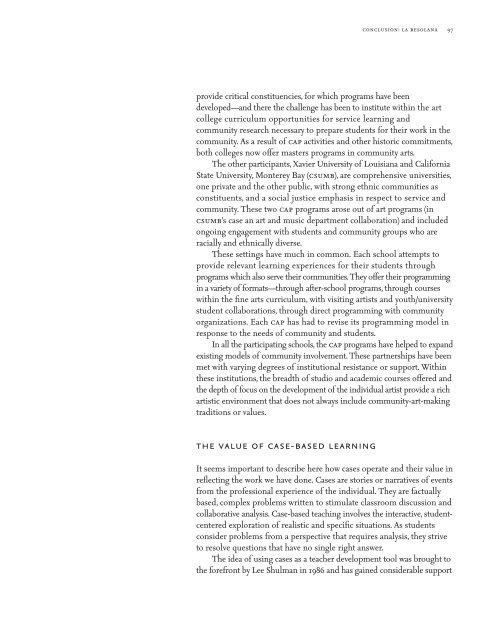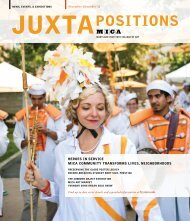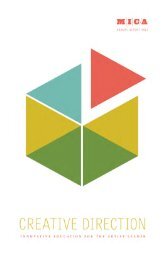art/vision/voice - Maryland Institute College of Art
art/vision/voice - Maryland Institute College of Art
art/vision/voice - Maryland Institute College of Art
Create successful ePaper yourself
Turn your PDF publications into a flip-book with our unique Google optimized e-Paper software.
provide critical constituencies, for which programs have been<br />
developed—and there the challenge has been to institute within the <strong>art</strong><br />
college curriculum opportunities for service learning and<br />
community research necessary to prepare students for their work in the<br />
community. As a result <strong>of</strong> cap activities and other historic commitments,<br />
both colleges now <strong>of</strong>fer masters programs in community <strong>art</strong>s.<br />
The other p<strong>art</strong>icipants, Xavier University <strong>of</strong> Louisiana and California<br />
State University, Monterey Bay (csumb), are comprehensive universities,<br />
one private and the other public, with strong ethnic communities as<br />
constituents, and a social justice emphasis in respect to service and<br />
community. These two cap programs arose out <strong>of</strong> <strong>art</strong> programs (in<br />
csumb’s case an <strong>art</strong> and music dep<strong>art</strong>ment collaboration) and included<br />
ongoing engagement with students and community groups who are<br />
racially and ethnically diverse.<br />
These settings have much in common. Each school attempts to<br />
provide relevant learning experiences for their students through<br />
programs which also serve their communities. They <strong>of</strong>fer their programming<br />
in a variety <strong>of</strong> formats—through after-school programs, through courses<br />
within the fine <strong>art</strong>s curriculum, with visiting <strong>art</strong>ists and youth/university<br />
student collaborations, through direct programming with community<br />
organizations. Each cap has had to revise its programming model in<br />
response to the needs <strong>of</strong> community and students.<br />
In all the p<strong>art</strong>icipating schools, the cap programs have helped to expand<br />
existing models <strong>of</strong> community involvement. These p<strong>art</strong>nerships have been<br />
met with varying degrees <strong>of</strong> institutional resistance or support. Within<br />
these institutions, the breadth <strong>of</strong> studio and academic courses <strong>of</strong>fered and<br />
the depth <strong>of</strong> focus on the development <strong>of</strong> the individual <strong>art</strong>ist provide a rich<br />
<strong>art</strong>istic environment that does not always include community-<strong>art</strong>-making<br />
traditions or values.<br />
the value <strong>of</strong> case-based learning<br />
conclusion: la resolana 97<br />
It seems important to describe here how cases operate and their value in<br />
reflecting the work we have done. Cases are stories or narratives <strong>of</strong> events<br />
from the pr<strong>of</strong>essional experience <strong>of</strong> the individual. They are factually<br />
based, complex problems written to stimulate classroom discussion and<br />
collaborative analysis. Case-based teaching involves the interactive, studentcentered<br />
exploration <strong>of</strong> realistic and specific situations. As students<br />
consider problems from a perspective that requires analysis, they strive<br />
to resolve questions that have no single right answer.<br />
The idea <strong>of</strong> using cases as a teacher development tool was brought to<br />
the forefront by Lee Shulman in 1986 and has gained considerable support
















